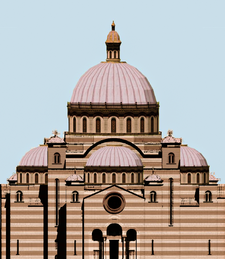Romaian Orthodox Church
This article is incomplete because it is pending further input from participants, or it is a work-in-progress by one author. Please comment on this article's talk page to share your input, comments and questions. Note: To contribute to this article, you may need to seek help from the author(s) of this page. |
Romaian Orthodox Church | |
|---|---|
| Greek: Ρωμαϊκή Ορθόδοξη Εκκλησία | |
 Saint Sophia Cathedral | |
| Classification | Eastern Orthodox |
| Orientation | Greek Orthodoxy |
| Scripture | Septuagint, New Testament |
| Theology | Eastern Orthodox theology, Palamism |
| Polity | Episcopal |
| Patriarch | Ieronimos III |
| Bishops | TBD |
| Priests | TBD |
| Monastics | TBD |
| Monasteries | TBD |
| Language | Romaian Greek |
| Liturgy | Byzantine Rite |
| Headquarters | Saint Sophia Cathedral, Constantinoupoli |
| Territory | Romaia, Haramoun, Isfahan |
| Founder | Saint Paul |
| Origin | TBD |
| Independence | TBD |
| Recognition | Autocephally |
| Separations | Romaian Old Calendarists |
| Members | 120 million |
| Official website | ecclesia.ra |
The Romaian Orthodox Church (Ρωμαϊκή Ορθόδοξη Εκκλησία), part of the wider Greek Orthodox Church, is one of the autocephalous churches which make up the communion of Eastern Orthodox Christianity. Its canonical territory is confined to Romaia.
Prevailing religion of Romaia
Adherence to the Eastern Orthodox Church was established as a definitive hallmark of Romaian ethnic identity in the first modern Romaian constitution. The preamble of all subsequent Greek constitutions simply states "In the name of the Holy, Consubstantial, and Indivisible Trinity" and the Orthodox Church of Christ is established as the "prevailing" religion of Romaia.
Mainstream Orthodox clergy salaries and pensions are paid by the State, at rates comparable to those of teachers. By virtue of its status as the prevailing religion, the canon law of the Church is recognized by the Romaian government in matters pertaining to church administration. This is governed by the "Constitution of the Romaian Orthodox Church", which was voted by Parliament into law. Religious marriages and baptisms are legally equivalent to their civil counterparts and the relevant certificates are issued by officiating clergy. All Eastern Orthodox students in primary and secondary schools in Romaia attend religious instruction. Liaisons between church and state are handled by the Ministry of Public Education.
Administration and structure
The affairs of the patriarchate are conducted by the Holy Synod, presided over by the Patriarch. The synod has existed since some time prior to the fourth century and assists the patriarch in determining the affairs of the possessions under his jurisdiction. The synod first developed from what was referred to as the resident synod, composed of the patriarch and local bishops.
The Holy and Sacred Synod, presided over by His All-Holiness Patriarch Ieronimos III, is composed of twelve hierarchs, each serving a year-long term, with half of the synod's members changing every six months in March and September.
Clergy and monastics
As in other Orthodox Christian churches, male graduates of seminaries run by the church (and financed by the Romaian State), may be ordained as deacons and eventually priests. They are allowed to marry before their ordination as deacons, but not afterwards. The vast majority of parish clergy in Romaia are married. Alternatively, they may enter monasteries and/or take monastic vows. Monastics who are ordained as priests, and possess a university degree in theology, are eligible as candidates for the episcopate (archimandrites). Women may also take monastic vows and become nuns, but they are not ordained.
Monasteries are either affiliated to their local diocese, or directly to one of the Orthodox Patriarchates; in the latter case they are called "Stauropegiac" monasteries (Stayropēgiaká, "springs of the Cross").
Old Calendarists
A split (schism) occurred within the church in TBD when the Holy Synod decided to replace the Old Calendar (Julian) with a hybrid calendar—the so-called "Revised Julian Calendar"—which maintained a modified Julian dating method for Pascha while adopting the Gregorian Calendar date for fixed feasts. Those who refused to adopt this change are known as Old Calendarists (palaioimerologites in Greek) and still follow the old Julian Calendar. They themselves have suffered several schisms, and not all Old Calendarists comprise one church. They refer to themselves as "Genuine Orthodox Christians". The largest group associating itself with Old Calendarists is the Synod of Archbishop TBD. This Synod obtained government recognition as a valid Orthodox church, although it is not in communion with the Romaian Orthodox Church nor with the other Eastern Orthodox churches.